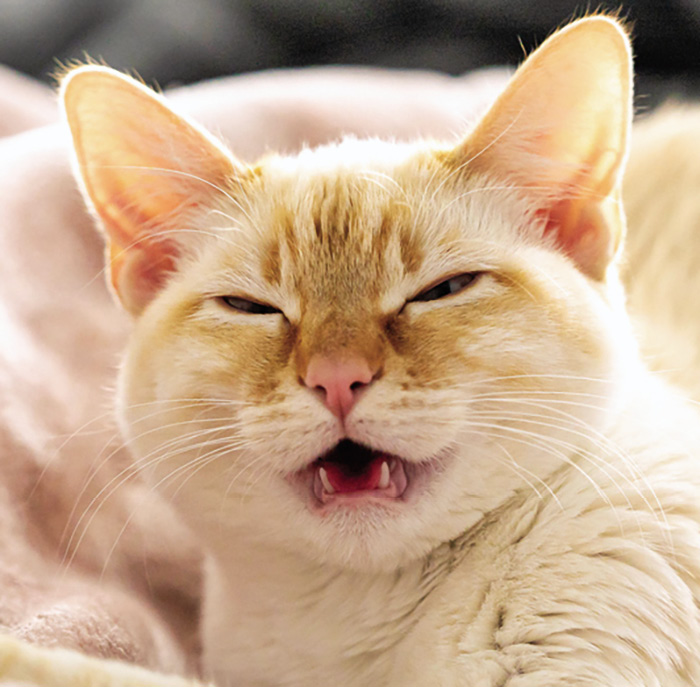While asthma is by far the most common cause of coughing in cats, diseases affecting the larynx (voice box) come in second. You might expect upper respiratory infections (congestion, runny nose, sneezing) and heart failure (increased respiratory rate, trouble breathing) to cause coughing, but in cats they usually don’t.
Signs of laryngeal disease in cats include:
- Voice changes
- Noisy breathing
- High-pitched wheezing
- Bad breath
- Increased respiratory effort
- Open-mouth breathing
- Lowered head with neck stretched
- Difficulty swallowing
- Cough, especially after eating or drinking
“We do see cases of laryngeal disease from time to time,” says John Loftus, PhD, DVM, DACVIM, section chief, small animal internal medicine at Cornell University’s College of Veterinary Medicine. Laryngeal disease can lead to severe respiratory distress, even complete airway obstruction, necessitating emergency placement of a tracheotomy tube to preserve life and buy time for the diagnostic process.
Diagnosing laryngeal disease starts with x-rays to rule out masses, foreign bodies, and any anatomical derangements. The next steps include laryngoscopy (endoscopic examination of the larynx) and/or echolaryngography (ultrasound exam of the larynx), followed by fine needle aspirate or biopsy if a mass is found. These diagnostics are typically performed by specialists in a referral setting.
Multiple Possible Causes
Causes of laryngeal disease may include:
- Laryngitis
- Laryngeal tumors
- Laryngeal paralysis
- Laryngeal collapse
- Laryngeal trauma with swelling
- Laryngeal cysts, polyps, abscesses
- Inhaled foreign bodies
Laryngitis can be caused by respiratory viruses, trauma to the throat, and irritation from airborne pollutants like dust and smoke. Severe allergic reactions can cause laryngitis with enough inflammation and swelling to cause airway obstruction. Treatment for laryngitis includes steroid therapy and pain management. Humidifying the air and feeding soft food is helpful, as is confinement to encourage rest.
The results of two relatively recent studies suggest that laryngeal neoplasia (cancer) and laryngeal paralysis are the two most common presentations of laryngeal disease in cats.
Laryngeal neoplasia occurs most frequently in geriatric cats. Signs may be mild at first but will usually worsen as the tumor grows.
The problem with tumors in this location is that, even if they are benign, they can be difficult or impossible to remove, and an affected cat can’t live with them as they progress to complete airway obstruction. Permanent tracheotomy for palliation is, unfortunately, not well tolerated by cats. This all factors into a poor prognosis for feline laryngeal tumors.
Laryngeal paralysis occurs when there is damage or disruption to the recurrent laryngeal nerve or vagus nerve in the neck or chest.
Normally, every time a breath is taken the vocal folds open wide to allow the passage of air. With laryngeal paralysis, the vocal folds don’t move, they just flutter in the breeze and impede the passage of air. As the cat pulls harder to get air, the vocal folds start to swell, causing even more resistance to air flow. Cats with laryngeal paralysis tend to regurgitate and often end up with aspiration pneumonia. These cats frequently go downhill quickly.
“At Cornell, I would say we see laryngeal neoplasia or inflammatory conditions (laryngitis, granulomas) most frequently,” says Dr. Loftus. “I don’t recall ever having a feline laryngeal paralysis case, and I believe it is considered quite rare.”
What You Can Do
If your cat is showing signs of laryngeal disease, see your veterinarian. If laryngeal paralysis is suspected, medical treatment in the form of steroids to decrease swelling, sedation to keep your cat calm, oxygen supplementation, and antibiotics for aspiration pneumonia, if present, can help your cat feel and breathe better, at least in the short term. Any cat who presents with trouble breathing due to laryngeal paralysis is a candidate for surgery.
The surgical procedure most often used to treat laryngeal paralysis is called a unilateral arytenoid lateralization, or “tieback” surgery. With this procedure, one of the vocal folds is sutured to the side wall of the larynx, thereby creating and maintaining an open airway. This is a much more permanent solution than medical therapy, and many cats do well afterward, although they will always be prone to aspiration pneumonia.
Even though laryngeal disease in cats is rare, knowing what to watch for could mean the difference between getting your cat the help he or she needs early in the disease process and having to rush in as an emergency with your gasping cat.ν
Taylor, S.S. , et al. “Laryngeal disease in cats: a retrospective study of 35 cases,” Journal of Feline Medicine and Surgery (2009) 11, 954-962
Lam, A. et al. “Laryngeal disease in 69 cats: a retrospective multicentre study,” Aust Vet Pract 2012; 42 (4): 321-326
John Loftus, PhD, DVM, DACVIM, is section chief, small animal internal medicine at Cornell University’s College of Veterinary Medicine.




